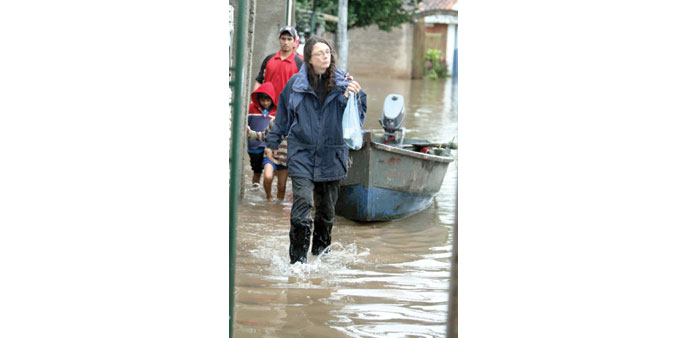DELUGE: People walk through a flooded street in the city of Asuncion, Paraguay. The number of people that have been displaced due to the floods in the country has surpassed 100,000 due to the heavy rains in the last days, according to Unicef.
By Steff Gaulter
The World Cup is in full swing and there have been plenty of surprises, both on and off the pitch. As expected, the Brazilian weather has already been quite a talking point. Not only has there the humidity of the tropical rainforest for some of the teams to contend with, but for the opening match in Natal, there was also a tropical downpour.
Ironically Natal is known as the ‘City of Sun’, but during the match between Cameroon and Mexico there was certainly no sign of the big yellow ball in the sky. Flooding snarled up the traffic, meaning the majority of the fans had to endure a long walk to the stadium. In other parts of the city the situation was even worse, and a landslide destroyed over 25 homes.
In the south of Brazil, the rain has also been causing problems. In fact this is where the effects have been far more long-lasting and more widespread. Weeks of heavy downpours in Paraguay and southern Brazil have caused land to become waterlogged and flooded. As the rain continued, many of the rivers overflowed their banks, causing the flooding to become far more widespread.
In Paraguay over 1,00,000 people were forced to evacuate their homes as the River Paraguay overflowed. The majority of those people affected were in the capital Asuncion. In Brazil, it was the Parana River which caused the majority of the damage.
The excess water flooded vast areas in the state of the same name. As many as 13,000 people have had to evacuate their homes. Parana isn’t just a state in a far-flung part of Brazil, it’s capital is one of the World Cup locations, Curitiba.
The flooding has been plaguing southern Brazil for a number of weeks now, with the Parana River simply unable to cope with the extreme amount of water. The Parana is the second longest river in South America, after the Amazon, and it flows a staggering 4,880km (3050 miles) in length. It runs through southern Brazil, forming the border between Brazil and Paraguay, then Paraguay and Argentina, before flowing through Argentina, all the way to Buenos Aires where it finally reaches the sea.
This means that if the river floods upstream, the water has a long way to travel before it can be released into the sea.
On the border between Paraguay and Brazil, a huge hydroelectric power station was built in the 1970s. The dam, known as Itaipu, generates more electricity per year than anywhere else in the world, even beating the Three Gorges Dam in China. This huge power plant generates electricity for both Brazil and Paraguay, providing up to 90% of the electricity in Paraguay.
Like all dams, Itaipu has floodgates which can be opened in exceptional weather to maintain the water of the dam. As the water surged down the Parana River, it was decided that the gates should be opened. This was no doubt a good thing for Brazil, but inevitably had consequences further downstream.
Water was raging down the other rivers in the area. This includes the Iguazu River, which forms the border between Brazil and Argentina. The river cascades over the impressive Iguazu waterfalls before joining the Parana river south of the Itaipu dam.
The vast waterfalls of Iguazu span a width of 2,800m (1.7miles), and are so impressive that in the 1930s when the United States’ First Lady Eleanor Roosevelt initially set eyes on the falls she exclaimed “Poor Niagara”!
At this time of year, the usual volume of water which flows down the river is about 1,500cu m per second. On June 7 this year, the flow had reached 2,300cu m per second. This might sound like a lot of water, but just three days later, this had soared to a worrying 43,000cu m per second.
This was an even more powerful water surge than that seen in 1992, when sections of the walkways were ripped apart and it took 20 days to repair the tourist circuit. Understandably, this year the authorities at Iguazu took evasive action, closing most of the tourist trails and suspending visits to the park. Further downstream, several river ports, including Libertad and Eldorado, were closed.
Fortunately this month, as the water roared down the Iguazu River, Iguazu National Park escaped largely unscathed, but a floating casino was ripped from its moorings and tossed down the river.
The surging waters of the Iguazu River joined the water let through the floodgates of Itaipu dam and surged into northern Argentina. Several major cities along the river were affected, including Posadas and Corrientes. Thousands of people had to be evacuated as the waters surged downstream.
The flood waters are now receding, but unfortunately there is the risk that flooding in this region could recur sooner rather than later. In the Pacific Ocean, El Nino conditions are emerging. El Nino is the slight warming of the waters of the Pacific Ocean which can affect the weather around the world.
Southern Brazil and Northern Argentina is one of the regions which often endure torrential rain during an El Nino year, especially between December and February. This could well bring more flooding and is certainly something that meteorologists around the world will be keeping a very close eye on.



